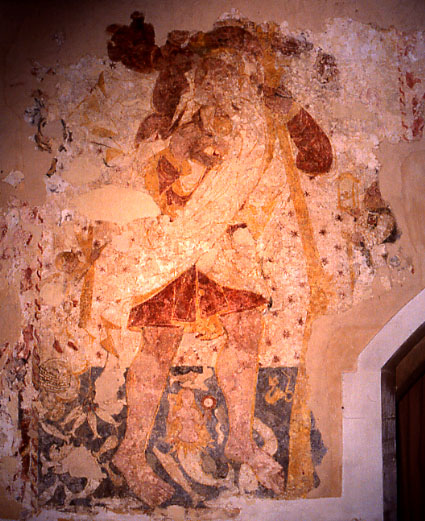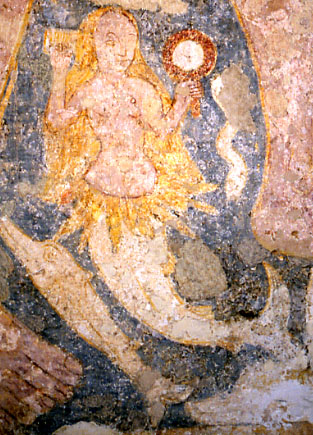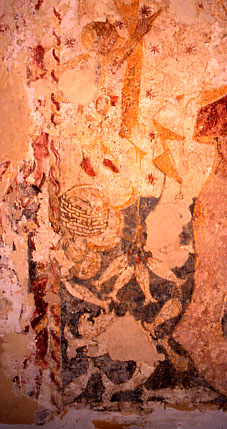Oaksey, Wiltshire (†Bristol) C.15
St Christopher

This very colourful St Christopher has undoubtedly been restored at some time, but the obvious delight in background detail is typical of later examples of the subject. In fact some of this detail threatens to overwhelm the figures of Christopher and the Christ Child he carries, but I suspect that this was probably less apparent when the painting was new.
Damage to much of the upper part of the two principal figures in the centre of the painting makes it difficult to see exactly where the Christ Child was in relation to the saint, but enough is left for identification, and the original dimensions of the painting can be judged from the spiralling “twisted rope” design used as a border and found elsewhere in 15th century painting.
At the right beyond Christopher’s left elbow is what remains of the Hermit, holding up his lantern, and lower down, in the blue water just below the line marking the horizon, a tiny, convoluted, but extremely benign-looking sea serpent, painted in dark yellow ochre, looks up at the saint.

The detail below at the right shows more of the background, including one of the more imaginative touches typical of this period, a mermaid, with mirror and comb, who appears between Christopher’s feet, with a dolphin below her at the left. She resembles her counterpart at Slapton in the general articulation of her figure, apart from her long yellow hair and the strange rayed frill marking the junction between torso and tail.

Aquatic life of various kinds surges around St Christopher, and at the left is a detail of the left-hand side of the painting, showing a rocky coastline in the background. Prominent on the bank at the far left is a woven basket or creel, with at least one fish in it. The fisherman on the bank is obscure and damaged, but his head and red shoes are visible, and he might be pointing, presumably at Christopher, with his raised left hand. His rod is in his right, and four fish dangle from the end of his line. If there is any symbolic meaning here, then it is not obvious. Other fish cluster below, and the spiral vertical line of the painting’s border, referred to above, shows best here.
The Warning to Sabbath Breakers at Oaksey has been on the site for some time. Information on the paintings here is scanty, but such an eventful St Christopher is likely, I think, to be rather later than the date of around 1400 given by Caiger-Smith. Rouse includes Oaksey in his Gazetteer but has no other details, Tristram could see only traces of decorative work in the church, Keyser does not mention it at all and neither does HC Whaite. An article ¹ mentioned by Tristram might provide further information, but I think he would have summarised its content if it does.
Website for Oaksey Village church
¹ Tristram III, 231, fn, Goddard, Wiltshire Archaeological & Natural History Magazine, 1935-7, XLVII, 632-6M
† in page heading = Diocese